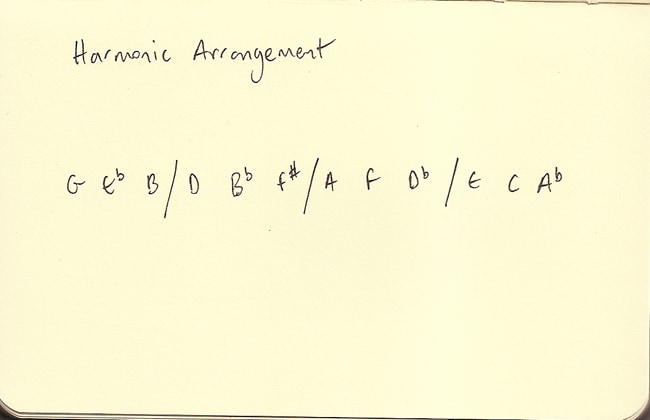Here’s a thing you can use to practise in all keys.
Take all 12 keys and arrange them into four groups.
The groups are organised in cycles of fifths: G D A E
Each group has three notes arranged in descending major thirds:
- G Eb B
- D Bb F#
- A F Db
- E C Ab
Why?
The keys are arranged like this so that each time you change key about half the notes change. And that’s different to the usual way of playing things through all keys where you’ll change key by going through the cycle of 4ths: C F Bb Eb, etc.
This is good because you’ll be forced to think about what you’re playing rather than relying on finger shapes. [tut, tut, tut!]
Try This
Play four ascending notes in the first key (G), and start from the lowest available note.
Then when you shift to the next key (Eb), move to the next available note in that key, and play four notes in Eb.
Carry on through all the keys, going to the highest note on your instrument and then back to the lowest.
Continue doing this.
As you play the notes, say out loud the note-name or the function.
So that might go something like this:
E F# G A – Bb C D Eb – E F# G# A# – B C# D E – F G A Bb – etc.
If you say the function whilst you play the notes you’d say: 6 7 1 2 – 5 6 7 1 – 4 5 6 7 – 6 7 1 2 – 5 6 7 1 – etc.
Can you see that there’s a pattern in the above example?
Maybe you can see it more easily if I write it like this:
-
6 7 1 2
-
5 6 7 1
-
4 5 6 7
Good to notice stuff like this, I think. As you play this exercise, you’ll find the pattern gets altered at various points.
Can you see why?
So there you go. Just by using that harmonic arrangement, you’re working on your understanding of keys. And that’s going to REALLY help you when it comes to being able to keep your ideas developing whilst not being derailed by the chord changes.
Signing off,
Mike

Nice! I’m glad it’s getting easier :)
Important to just keep doing it!
Thanks Mike! Yes that is the kind of thing I mean. I can definitely see some patterns looking at different groupings. I guess I was surprised such a clear pattern emerged ascending with 4 note groupings but no clear pattern descending with 4 note groupings.
Looking at this has helped me generally place my focus on the note functions at least. I am surprised how less challenging this exercise has become over time.
Try different groupings, eg, try three notes descending.
Also, the patterns crop up in funny ways. Eg, Descending 4 notes you’d get this pattern (this is the function of the first note of each group of 4: 165, 654, 542, 421. See the pattern? 65/65, 54/54, 42/42.
That the kind of thing you mean?
Hi Mike,
I can see the pattern clearly ascending and can interpret or think about it in different ways.
In terms of the function of the notes a pattern will repeat for each group of three keys arranged in descending major thirds – repeating each time it shifts up a minor third:
Starting on 1st degree: [1234 7123 6712] [1234 7123 6712] [1234 7123 6712]
Starting on 2nd degree: 2345 1234 7123 etc.
Each set of 4 notes will begin minus one tone from the previous note set (until you reach the shift up a minor 3rd).
I prefer to think of the movement of the last note function in each 4 note set when playing through this: +3,+3,-1,+3,+3,-1,+3,+3,-1
What troubles me is when I change the note movement from ascending to descending through the keys I can’t identify a pattern. I don’t know whether there is a pattern and I am missing it or why there is not pattern. Help!